Philip Johnson
Philip Cortelyou Johnson (July 8, 1906 – January 25, 2005) was an American architect best known for his works of modern and postmodern architecture. Among his best known designs are his modernist Glass House in New Canaan, Connecticut, and postmodern 550 Madison Avenue in New York, designed for AT&T, and 190 South La Salle Street in Chicago.
Philip Johnson | |
|---|---|
 Johnson aged 95, with a model of a privately commissioned sculpture (2002) | |
| Born | Philip Cortelyou Johnson July 8, 1906 Cleveland, Ohio, U.S. |
| Died | January 25, 2005 (aged 98) New Canaan, Connecticut, U.S. |
| Nationality | American |
| Alma mater | Harvard Graduate School of Design |
| Occupation | Architect |
| Awards | Pritzker Prize (1979) AIA Gold Medal (1978) |
| Buildings | Glass House, Seagram Building, 550 Madison Avenue, IDS Tower, PPG Place, Crystal Cathedral |
In 1978, he was awarded an American Institute of Architects Gold Medal and in 1979 the first Pritzker Architecture Prize.[1]
Early life and the Museum of Modern Art exhibition

Johnson was born in Cleveland, Ohio, on July 8, 1906, the son of a lawyer, Homer Hosea Johnson (1862–1960), and the former Louisa Osborn Pope (1869–1957), a niece of Alfred Atmore Pope and a first cousin of Theodate Pope Riddle. He had an older sister, Jeannette, and a younger sister, Theodate. He was descended from the Jansen family of New Amsterdam, and included among his ancestors the Huguenot Jacques Cortelyou, who laid out the first town plan of New Amsterdam for Peter Stuyvesant. He grew up in New London, Ohio[2] and attended the Hackley School, in Tarrytown, New York, and then studied as an undergraduate at Harvard University where he focused on learning Greek, philology, history and philosophy, particularly the work of the Pre-Socratic philosophers. Upon completing his studies in 1927, he made a series of trips to Europe, visiting the landmarks of classical and Gothic architecture, and joined Henry-Russell Hitchcock, a prominent architectural historian, who was introducing Americans to the work of Le Corbusier, Walter Gropius, and other modernists. In 1928 he met German architect Ludwig Mies van der Rohe, who was at the time designing the German Pavilion for the 1929 Barcelona International Exposition. The meeting formed the basis for a lifelong relationship of both collaboration and competition[3][4]
In 1930, Johnson joined the architecture department of the Museum of Modern Art in New York. There he arranged for American visits by Gropius and Le Corbusier, and negotiated the first American commission for Mies van der Rohe. In 1932, working with Hitchcock and Alfred H. Barr, Jr., he organized the first exhibition on Modern architecture at the Museum of Modern Art.[5] The show and their simultaneously published book International Style: Modern Architecture Since 1922 played an important part in introducing modern architecture to the American public. His flirtation with fascism and the Nazi party was documented in Marc Wortman's 2016 book 1941: Fighting the Shadow War. It was excerpted by Vanity Fair magazine.[6] When the rise of the Nazis in Germany forced the modernists Marcel Breuer and Mies van der Rohe to leave Germany, Johnson helped arrange for them to come to work in the United States.[7]
Franz Schulze, Philip Johnson: Life and Work (1994), p.144[8]
In 1936, in the depths of the Great Depression, he left the Museum of Modern Art for a brief venture into journalism and politics. He was a Nazi sympathizer[6][5][9][10] and supported the populist Governor of Louisiana Huey Long and Father Charles Coughlin. Johnson traveled to Germany and Poland as a correspondent for Coughlin's radically populist and often anti-Semitic newspaper Social Justice. In the newspaper, Johnson expressed, as the New York Times later reported, "more than passing admiration for Hitler".[3] Johnson observed the Nuremberg Rallies in Germany and, sponsored by the German government, covered the invasion of Poland in 1939. Many years later he told his biographer, Franz Schulze, "You simply could not fail to be caught up in the excitement of it, by the marching songs, by the crescendo and climax of the whole thing, as Hitler came on at last to harangue the crowd," and told of being thrilled at the sight of "all those blond boys in black leather" marching past the Führer.[8]:89–90 Schulze dismissed these early political activities as inconsequential, concluding they merited "little more substantial attention than they have gained" and his politics "were driven as much by an unconquerable esthetic impulse as by fascist philosophy or playboy adventurism".[8]:144;146
In 1941, at the age of 35, Johnson abandoned politics and journalism and enrolled in the Harvard Graduate School of Design, where he studied with Marcel Breuer and Walter Gropius. In 1941, Johnson designed and actually built his first building, a house that still exists at 9 Ash Street in Cambridge, Massachusetts. The house, strongly influenced by Mies van der Rohe, has a wall around the lot which merges with the structure.[11] It was used by Johnson to host social events and was eventually submitted as his graduate thesis; he sold the house after the War, and it was eventually purchased by Harvard in 2010[12] and restored by 2016.[13]
After the United States entered World War II in December 1941, Johnson enlisted in the Army. He was investigated by the FBI for his contacts with the German government and his support for Coughlin, who opposed American intervention in the war, but he was cleared for service and entered the army. He spent his army service during the war in the United States.[3][14]
Modernist period (1949–1979)
 The Glass House (1949)
The Glass House (1949) Interior of the Glass House (1949)
Interior of the Glass House (1949)- Sculpture garden of the Museum of Modern Art, New York (1953)
.jpg) Congregation Kneses Tifereth Israel Synagogue in Port Chester, New York (1954–1956)
Congregation Kneses Tifereth Israel Synagogue in Port Chester, New York (1954–1956)- Seagram Building (1958)
- Monastery building at St. Anselm's Abbey in Washington DC (1960)
 Atrium of the New York State Theater at Lincoln Center (1964)
Atrium of the New York State Theater at Lincoln Center (1964) The Kunsthalle Bielefeld art museum in Bielefeld, Germany (1968)
The Kunsthalle Bielefeld art museum in Bielefeld, Germany (1968) The Johnson Building at Boston Public Library, Boston, Massachusetts (1972)
The Johnson Building at Boston Public Library, Boston, Massachusetts (1972) IDS Center in Minneapolis (1973)
IDS Center in Minneapolis (1973)- Pennzoil Place in Houston, Texas (1970–1976)
 Thanks-Giving Square in Dallas, Texas (1977)
Thanks-Giving Square in Dallas, Texas (1977)
In 1946, after he completed his military service, Johnson returned to the Museum of Modern Art as a curator and writer. At the same time, he began working to establish his architectural practice. He built a small house, in the style of Mies, in Saaponack, Long Island in 1946. This was followed by one of his most famous buildings, which he built for himself; the Glass House in New Canaan, Connecticut, completed in 1949, which has become a landmark of modern architecture.[3]
The Glass House

The Glass House (1949) that he designed as his own residence in New Canaan was influenced by the Farnsworth House, built shortly before it by Mies van der Rohe, an influence which Johnson never denied. [7] Johnson had curated an exhibit of Mies van der Rohe's at the Museum of Modern Art in 1947, featuring a model of the glass Farnsworth House.[15]
The house is a 56 foot by 32 foot glass rectangle, sited at the edge of a crest on Johnson's estate overlooking a pond. The building's sides are glass and charcoal-painted steel; the floor, of brick, is not flush with the ground but sits 10 inches above. The interior is an open space divided by low walnut cabinets; a brick cylinder contains the bathroom and is the only object to reach floor to ceiling. The New York Times described it in 2005 as "one of the 20th century's greatest residential structures. "Like all of Johnson's early work, it was inspired by Mies, but its pure symmetry, dark colors and closeness to the earth marked it as a personal statement; calm and ordered rather than sleek and brittle."[3]
Johnson continued to add to the Glass House estate during each period of his career. He added a small pavilion with columns by the lake in 1963, an art gallery set into a hillside in 1965, a postmodern sculpture gallery with a glass roof in 1970; a castle-like library with a rounded tower in 1980; a concrete block tower dedicated to his friend Lincoln Kirstein, the founder of the New York City Ballet; a chain-link "ghost house" dedicated to Frank Gehry.[3]
After completing the Glass House, he completed two more houses in New Canaan in a style similar to that of Mies; the Hodgson House (1951) and the Wiley House (1953). In 1953 he also created an architectural sculpture garden for the Museum of Modern Art in New York.[7]
The Seagram Building
Johnson joined Mies van der Rohe as the New York associate architect for the 39-story Seagram Building (1956). Johnson was pivotal in steering the commission towards Mies by working with Phyllis Lambert, the daughter of the CEO of Seagram. The commission resulted in the iconic bronze-and-glass tower on Park Avenue. The building was designed by Mies.The interiors of the Four Seasons and Brasserie restaurants were designed by Johnson[16]
Further development
_(cropped).jpg)
Following the Seagram Building, Johnson built several smaller projects in a more personal, expressive style, with ornament touches and features far from the sobriety of the modernist style; the Synagogue of Port Chester New York, with a plaster vaulted ceiling and narrow colored windows (1954–56); the Art Gallery of the University of Nebraska with an array of symmetrical arcs (1963); (the Roofless Church in New Harmony, Indiana with a mushroom-shaped roof covered with wood shingles (1960). In 1960 he also built a severely modernist monastery building for in the expansion of St. Anselm's Abbey in Washington, D.C.[17]
In the same period, Johnson won commissions to coordinate the master plan of Lincoln Center, New York City's new arts center, and to design that complex's New York State Theater, built in a massive and unadorned modernist style. He also undertook his first foreign commission, the Kunsthalle Bielefeld art museum in Bielefeld, Germany, with a modernist facade clad in dark red stone, and a modernist colonnade of slender pillars (1968).
In 1967 Johnson entered a new phase of his career, founding a partnership with architect John Burgee. Johnson and Burgee won commissions for a series of new skyscrapers. including the IDS Center in Minneapolis (1973), and the two matching towers, facing each other like bookends, of Pennzoil Place in Houston, Texas. The two towers of Pennzoil Place have sloping roofs covering the top seven floors and are trapezoidal in form, created to leave two large triangual areas on the site, which are occupied with glass-covered lobbies designed like greenhouses. This idea was widely copied in skyscrapers in other cities. [18] [3]
In the late 1970s Johnson applied landscape architecture to two significant projects in Texas. The Fort Worth Water Gardens opened in 1974, creating an urban landscape where visitors experience water in distinct ways. And in 1977 Johnson completed the spiraling white chapel and meditation garden at Thanks-Giving Square in Dallas.
Postmodern period (1980–1990)
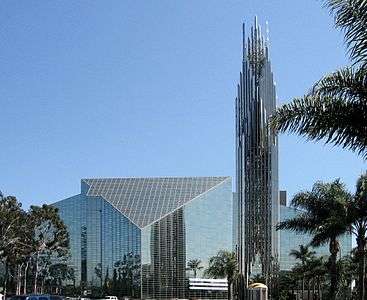 The Crystal Cathedral, Garden Grove, California (1980) and tower (1990)
The Crystal Cathedral, Garden Grove, California (1980) and tower (1990) The Williams Tower in Houston, Texas (1983)
The Williams Tower in Houston, Texas (1983) Center for the Fine Arts (now Miami Art Museum), downtown Miami (1983)
Center for the Fine Arts (now Miami Art Museum), downtown Miami (1983)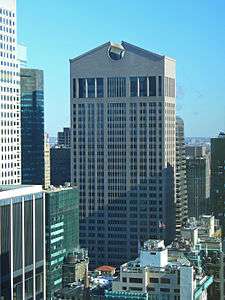 550 Madison Avenue (formerly AT&T building and Sony Building) (1984)
550 Madison Avenue (formerly AT&T building and Sony Building) (1984)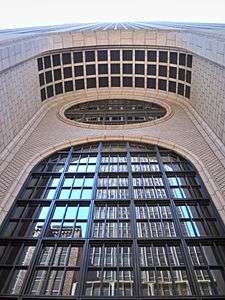 Main entrance of 550 Madison Avenue (1984)
Main entrance of 550 Madison Avenue (1984)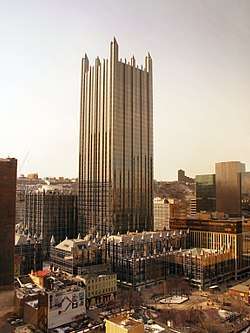 PPG Place in Pittsburgh, Pennsylvania (1984).
PPG Place in Pittsburgh, Pennsylvania (1984).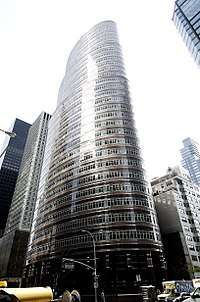 Lipstick Building, New York City (1986)
Lipstick Building, New York City (1986)
550 Madison Avenue (former AT&T Building) (1978–1984)
In 1980, Johnson completed a new building in a startling new style: the Crystal Cathedral in Garden Grove, California, a soaring glass neo-Gothic megachurch for the Reverend Robert H. Schuller. It became a Southern California landmark. In 2012 it was purchased by the Roman Catholic Diocese of Orange to become the cathedral for Orange County.
Shortly after the Crystal Cathedral, working in collaboration with John Burgee, he completed one of his most recognizable buildings, the AT&T building (later named the Sony Building, and now 550 Madison Avenue). Built between 1978 and 1982, a skyscraper with an eight-story high arched entry and a split pediment at the top which resembled an enormous piece of 18th-century Chippendale furniture. It was not the first work of Postmodern architecture—Robert Venturi and Frank Gehry had already built smaller scale postmodern buildings, and Michael Graves had completed the Portland Building in Portland Oregon (1980–82) two years before the AT&T Building; and most of the building was in a traditional modernist style; but because of its Manhattan location and size it became the most famous example of postmodern architecture.[19]
At about the same time as the AT&T Building, Johnson and Burgee completed other notable postmodern skyscrapers; the Bank of America Center (Formerly Republic Bank Center) in Houston (1983) and the PPG Place, the headquarters of the Pittsburgh Plate Glass company (1979–1984). Both buildings combined modern materials, construction and scale with suggestions of traditional architecture. The forms of PPG Place suggested the neogothic tower of the Houses of Parliament in London, while the Bank of America Center appeared inspired, on a colossal scale, the stepped houses of Flemish Renaissance architecture.[19]
Later career and buildings (1991–2005)
_Showroom.jpg) DDC (Domus Design Collection) Showroom at New York City – Main Showroom
DDC (Domus Design Collection) Showroom at New York City – Main Showroom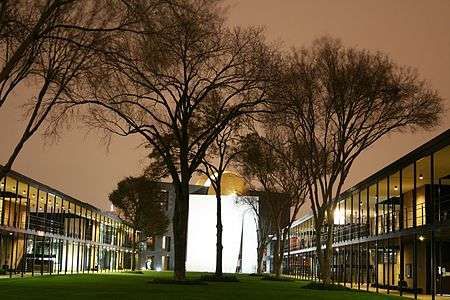 Chapel of St. Basil at the University of St. Thomas in Houston, Texas (1992)
Chapel of St. Basil at the University of St. Thomas in Houston, Texas (1992)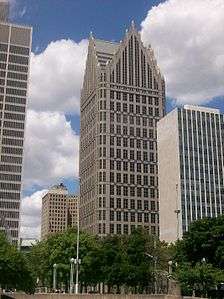 One Detroit Center in Detroit, Michigan (1991–1993)
One Detroit Center in Detroit, Michigan (1991–1993) "Da Monsta" the gatehouse of his Glass House residence (1995).
"Da Monsta" the gatehouse of his Glass House residence (1995).- Gate of Europe towers in Madrid, Spain (1989–96)
 Hines College of Architecture at the University of Houston (1985)
Hines College of Architecture at the University of Houston (1985)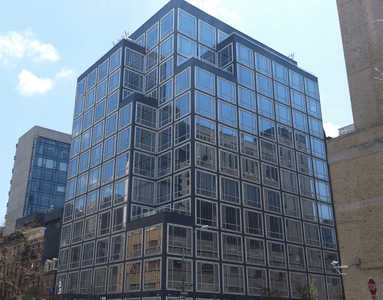 The Urban Glass House condominiums in New York (2006)
The Urban Glass House condominiums in New York (2006)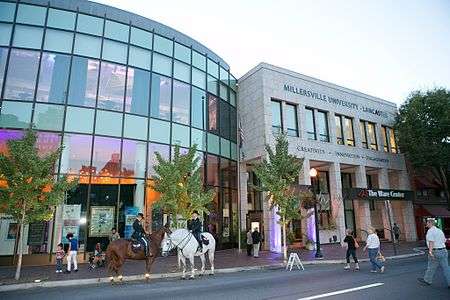 Pennsylvania Academy of Music (now The Ware Center) in Lancaster, Pennsylvania (2008)
Pennsylvania Academy of Music (now The Ware Center) in Lancaster, Pennsylvania (2008)
In 1986 Johnson and Burgee had moved their offices into one of their new buildings, the Lipstick building, the popular name of the skyscraper they built at 885 Third Avenue in New York, and given its nickname because of its resemblance to the color and shape of a stick of lipstick. Burgee, who wanted to play a larger role in the firm negotiated a smaller part for Johnson, and in 1988 the firm's name was changed to John Burgee Architects with Philip as the design consultant. By 1991 Johnson had split with Burgee and opened up his own practice.
Working with John Burgee, Johnson did not confine himself to a single style, and was comfortable mixing elements of modernism and postmodernism. For the Cleveland Play House, he built a romanesque brick structure; for the Architecture School at the University of Houston, he said that his model was the French neoclassical architecture of the 18th-century architect French Claude-Nicolas Ledoux. His skyscrapers on the 1980s were clad in granite and marble, and usually had some feature borrowed from historic architecture. In New York he designed the Museum of Television and Radio, (now the Paley Center for Media) (1991).
After four years as a solo practitioner, Johnson invited Alan Ritchie to join him as a partner. Ritchie had been a partner for many years in the Johnson-Burgee office and was the partner-in-charge of the AT&T building and the 190 South Lasalle Street office building. In 1994 they formed the new practice of Philip Johnson>Alan Ritchie Architects. During the next ten years they worked closely together and yet again explored new directions in architecture, designing buildings as sculptural objects. Some of the buildings that expressed this were the Chapel of St. Basil at the university of St. Thomas, the Cathedral of Hope in Dallas, the Habitable Sculpture (a 26-story apartment tower in lower Manhattan), The Children Museum in Guadalajara, Mexico, The Chrysler Center and DDC Showroom in NY. One of his last designs with Alan Ritchie, completed after his death, was the Urban Glass House, a condominium building in lower Manhattan which was an urban expression from his own earlier work, his famous Glass House residence. The final building he designed with Richie was the Pennsylvania Academy of Music building in Lancaster, Pennsylvania, which was completed in 2008. Alan Ritchie now continues the Johnson legacy and design excellence and continues to explore the many ideas they developed together.[20][21]
Honors
In 1978, Johnson was awarded an American Institute of Architects Gold Medal. In 1979 he became the first recipient of the Pritzker Architecture Prize the most prestigious international architectural award.[1]
In 1991, Johnson received the Golden Plate Award of the American Academy of Achievement.[22]
Personal life
Johnson was gay. He came out publicly in 1993, and was regarded as "the best-known openly gay architect in America."[23]
In 1934, Philip Johnson began his first serious relationship with Jimmie Daniels, a cabaret singer. The relationship lasted only one year.[24]
Johnson died in his sleep at his Glass House retreat on January 25, 2005, at the age of ninety-eight. His partner of 45 years, David Whitney,[25][26][27][28] died later that year at age 66.[29]
Johnson was among the public figures at the core of the effort to save Olana, the home of Frederic Edwin Church, before it was dedicated a National Historic Landmark in 1965 and subsequently became a New York State Historic Site.[30][31]
In his will Johnson left his residential compound to the National Trust for Historic Preservation. It is now open to the public.
Art collection and archives
As an art collector Johnson had an eclectic eye. He supported avant-garde movements and young artists often before they became widely known. His collection of American art was strong in Abstract expressionism, Pop Art, Minimalism, Neo-Dada, Color Field, Lyrical Abstraction, and Neo-Expressionism and he often donated important works from his collection to institutions like MoMA, and other important private museums and University collections like the Norton Simon Museum, the Sheldon Museum of Art and the Iris & B. Gerald Cantor Center for Visual Arts at Stanford University among many others.[3]
Johnson's publicly held archive, including architectural drawings, project records, and other papers up until 1964 are held by the Drawings and Archives Department of Avery Architectural and Fine Arts Library at Columbia University, the Getty, and the Museum of Modern Art.
Controversy over Nazi sympathies
Between 1932 and 1940, Johnson was an "antisemite, fascist sympathizer, and active propagandist for the Nazi government."[9] He attempted to start a fascist party in the United States.[10] As a correspondent for the newspaper Social Justice, which was edited by the antisemitic cleric Father Charles Coughlin, he made several trips to Germany, sympathetically covering the huge Nazi rally at Nuremberg and the German invasion of Poland in 1939. The American correspondent William Shirer who also covered the German invasion of Poland, noted his enthusiasm for the Germans and called him "The American fascist."[6]
A September 1940 article in Harper's listed Johnson as among leading American Nazis. An FBI investigation found that "Johnson had developed extensive contacts with the German Propaganda and Foreign Ministries while in Germany and then returned to propagandize on the Nazis' behalf in the United States." He was not prosecuted. However, when he was considered for a possible government position, an FBI agent sent a memo to J. Edgar Hoover saying, "I can think of no more dangerous man to have working in an agency which possesses so many military secrets."[6]
In his Social Justice report on his trip to Poland, author Marc Wortman has observed, "Johnson declared that the German victory amounted to an unmitigated triumph for the Polish people and that nothing in the war's outcome need concern Americans." Johnson went on to say that German forces had not significantly harmed Polish civilians, and said that "99 percent of the towns I visited since the war are not only intact but full of Polish peasants and Jewish shopkeepers." He said reports of Nazi mistreatment of Poles was "misinformed."[6]
Johnson wrote in Social Justice that "Lack of leadership and direction in the state has let the one group get control who always gain power in a nation's time of weakness—the Jews," he wrote. In a letter to a friend, he said, "We saw Warsaw burn and Modlin being bombed. It was a stirring spectacle."[32]
Johnson sought to distance himself from his views on Nazis after the outbreak of World War II.[33][34] In 1993 he told Vanity Fair, "I have no excuse (for) such unbelievable stupidity. ... I don't know how you expiate guilt."[9]
In 1956, he donated a design for Congregation Kneses Tifereth Israel in Port Chester, New York. Architecture professor Anat Geva observed in a paper that "all critics agree that his design of the Port Chester Synagogue can be considered as his attempt to ask for forgiveness," although Johnson never discussed the matter with the congregation. His biographer Schulze says the design was done "out of practicality not so much by shame following an investigation of his political activities."[10]
A 2018 New Yorker article notes that "in 1964, well after he had been forced to abjure his Nazi past, he insisted in letters that Hitler was 'better than Roosevelt.'"[5]
Quotations
- "I got everything from someone. Nobody can be original. As Mies van der Rohe said, 'I don't want to be original. I want to be good.'"[35]
- "Don't build a glass house if you're worried about saving money on heating."[35]
- "Everybody should design their own home. I'm against architects designing homes. How do I know that you want to live in a picture-window Colonial? It's silly, but you might want to. Who am I to say?"[35]
- "Architecture is the arrangement of space for excitement".[35]
- "Storms in this house (The Glass House) are horrendous but thrilling. Glass shatters. Danger is one of the greatest things to use in architecture."[35]
- "A room is only as good as you feel when you're in it".[35]
- "Merely that a building works is not sufficient."[36]
- "We still have a monumental architecture. To me, the drive for monumentality is as inbred as the desire for food and sex, regardless of how we denigrate it."[3]
In popular culture
He is mentioned in the song "Thru These Architect's Eyes" on the album Outside (1995) by David Bowie.
He appears in Nathaniel Kahn's My Architect, a 2003 documentary about Kahn's father, Louis Kahn.[37]
Philip Johnson's Glass House, along with Mies van der Rohe's Farnsworth House, was the subject of Sarah Morris's 2010 film Points on a Line. Morris filmed at both sites over the course of several months, among other locations including The Four Seasons Restaurant, the Seagram Building, Mies van der Roheʼs controversial 860–880 Lake Shore Drive Apartments, and Chicagoʼs Newberry Library.
References
- Goldberger, Paul (May 23, 1979). "Philip Johnson Awarded $100.000 Pritzker Prize: Retrieved August 1, 2011.
- Forms Under Light | The New Yorker Retrieved 2018-05-25.
- Goldberger, Paul (January 27, 2005). "Obituary: Philip Johnson, Architecture's Restless Intellect, dies at 98". The New York Times. Retrieved 15 May 2018.
- Saint, Andrew (January 29, 2005). "Philip Johnson — Flamboyant Postmodern Architect Whose Career Was Marred by a Flirtation with Nazism". The Guardian. Retrieved August 12, 2010.
- Saval, Nikil (12 December 2018). "Philip Johnson, the Man Who Made Architecture Amoral". Newyorker.com. Retrieved 12 December 2018.
- Wortman, Marc. "Famed Architect Philip Johnson's Hidden Nazi Past". Vanity Fair. Retrieved 12 December 2018.
- Taschen 2016, p. 314.
- Schulze, Franz (1996). Philip Johnson: Life and Work. Chicago: University of Chicago Press. ISBN 978-0-226-74058-4. Retrieved 15 May 2018.
- Varnelis, Kazys, Cornell University (November 1994). "We Cannot Not Know History: Philip Johnson's Politics and Cynical Survival". Journal of Architectural Education. Association of Collegiate Schools of Architecture, Inc. 49 (2): 92–104. doi:10.2307/1425400. Archived from the original on November 8, 2010. Retrieved 29 January 2013.
- Geva, Anat. "An Architect Asks For Forgiveness: Philip Johnson's Port Chester Synagogue" (PDF). Symposium of Architecture, Culture and Spirituality. ACS Forum. Retrieved 2014-06-17.
- Cahill, Frank M.; Harrington, Cleo M. (2 March 2017). "If Only We Could See It: Philip Johnson's Mystery House". The Harvard Crimson. Retrieved 17 May 2018.
- Sisson, Patrick (20 August 2015). "21 First Drafts: Philip Johnson's 9 Ash Street House". Curbed. Retrieved 17 May 2018.
- Harvard University Town Gown Report (PDF) (Report). Harvard Planning Office. 2016. p. 15. Retrieved 17 May 2018.
- "PHILIP JOHNSON". IDS Center. Retrieved January 29, 2015.
- Friedman, Alice T., Women and the Making of the Modern House, p 130, New Haven, Connecticut: Yale University Press (2006), ISBN 978-0-300-11789-9, retrieved via Google Books on August 8, 2010
- "Four Seasons & Brasserie Restaurants, Seagram Building, NYC". NYIT Architectural History. YouTube. May 4, 2012. Retrieved January 29, 2013.
- Taschen 2016, pp. 315–317.
- Taschen 2016, pp. 315-317.
- Taschen 2016, pp. 314–317.
- "Music Academy is Architect's Finale". Los Angeles Times. Retrieved 2017-04-11.
- "USA Architects to Design Renovations to the Pennsylvania Academy of Music Building". Usaarcitects.com. Retrieved 2017-04-11.
- "Golden Plate Awardees of the American Academy of Achievement". www.achievement.org. American Academy of Achievement.
- George Haggerty, ed. (2000). Gay Histories and Cultures: An Encyclopedia. 2. Taylor & Francis. p. 498. ISBN 9780815318804.
- Schulze, Franz (1996). Philip Johnson: Life and Work. University of Chicago Press. p. 93. Retrieved 4 October 2017.
- Pierce, Lisa, "Through the Looking Glass", August 1, 2010, pp 1, A4, The Advocate of Stamford, Connecticut
- Gutoff, Bija, "Philip Johnson: A Glass House Opens" Archived 2010-02-08 at the Wayback Machine, at Apple website, no date given, retrieved August 8, 2010
- Kennedy, Randy (June 14, 2005). "David Whitney, 66, Renowned Art Collector, Dies". The New York Times. Retrieved May 11, 2009.
- Bourdon, David (May 1970). "What's Up in Art, The Castelli Clan". Life. Accessed June 9, 2010.
- Glass House history chapter 1 Archived 2011-10-11 at the Wayback Machine
- Frederic Church's Olana on the Hudson. Hudson, NY: The Olana Partnership/Rizzoli International Publications. 2018. p. 191. ISBN 9780847863112.
- Smith, Roberta (May 30, 1999). "Artists in Residence; Architecture: A half-dozen houses in New York and Massachusetts paint revealing pictures of their famous inhabitants' talents and times". The Baltimore Sun. Retrieved May 11, 2020.
- Saval, Nikil (2018-12-12). "Philip Johnson, the Man Who Made Architecture Amoral". ISSN 0028-792X. Retrieved 2019-02-12.
- Stern, Robert A. M. (May 2005). "Philip Johnson: An Essay by Robert A.M. Stern". Architectural Record. Archived from the original on 7 May 2005. Retrieved August 12, 2010.
- Wortman, Marc (April 4, 2016). "Famed Architect Philip Johnson's Hidden Nazi Past". Vanity Fair. Retrieved 15 May 2018.
- Philip Johnson (February 1999). "Philip Johnson: What I've Learned". Esquire (Interview). Interviewed by John H. Richardson. Retrieved 15 May 2018.(subscription required)
- Johnson, Philip (1955). "The Seven Crutches of Modern Architecture". Perspecta. 3: 40–45. doi:10.2307/1566834. alternate URL
- "Film and Architecture 'My Architect'". Retrieved June 24, 2015.
Bibliography
- Schulze, Franz (1996). Philip Johnson: Life and Work. Chicago: University of Chicago Press. ISBN 978-0-226-74058-4. Retrieved 15 May 2018.
- Bony, Anne (2012). L'Architecture Moderne (in French). Larousse. ISBN 978-2-03-587641-6.
- Taschen, Aurelia; Taschen, Balthazar (2016). L'Architecture Moderne de A à Z (in French). Bibliotheca Universalis. ISBN 978-3-8365-5630-9.
- Prina, Francesca; Demaratini, Demartini (2006). Petite encyclopédie de l'architecture (in French). Solar. ISBN 2-263-04096-X.
- Hopkins, Owen (2014). Les styles en architecture- guide visuel (in French). Dunod. ISBN 978-2-10-070689-1.
- De Bure, Gilles (2015). Architecture contemporaine- le guide (in French). Flammarion. ISBN 978-2-08-134385-6.
- Lamster, Mark (2018). The Man in the Glass House: Philip Johnson, Architect of the Modern Century. Little, Brown and Company. ISBN 978-0316126434.
Further reading
- Lacayo, Richard (June 28, 2007). "Splendor in the Glass". Time. Accessed August 12, 2010.
- Philip Johnson: Diary of an Eccentric Architect, 1997 documentary.
- "Extending the Legacy" Alexandra Lange article on the preservation of the Glass House, from the November 2006 issue of Metropolis magazine.
- Philip Johnson article at Great Buildings Online. Retrieved Sep. 27, 2003.
- Philip Johnson bio on the Pritzker Architecture Prize website. Retrieved Sep. 27, 2003.
- Philip Johnson on NewsHour (1996). Retrieved Sep. 27, 2003.
- Heyer, Paul, ed. (1966). Architects on Architecture: New Directions in America, p. 279. New York: Walker and Company.
- One hour interview with Charlie Rose at Google Video (July 8, 1996)
- Other interviews with or about Phillip Johnson on Charlie Rose at Google Video
- Tomkins, Calvin (May 23, 1977). "Profile of Philip Johnson". The New Yorker.
- Jenkins, Stover, et al. The Houses of Philip Johnson, New York: Abbeville Publishing Group (Abbeville Press, Inc.), 2001.
External links
| Wikimedia Commons has media related to Philip Johnson. |
| Wikiquote has quotations related to: Philip Johnson |
- Obituary
- Philip Johnson at Find a Grave
- Philip Johnson architectural drawings, 1943-1994 (bulk 1943-1970).Held by the Department of Drawings & Archives, Avery Architectural & Fine Arts Library, Columbia University.
- The Architecture of Philip Johnson
- "Philip Johnson Biography and Interview". www.achievement.org. American Academy of Achievement.
- Finding aid for Philip Johnson architectural projects at the Getty Research Institute
- Finding aid for Philip Johnson papers at the Getty Research Institute